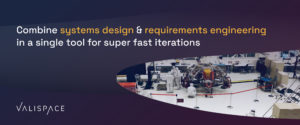
In the world of engineering, the synergy between systems design and requirements engineering is undeniable.
Both are critical elements in the product development lifecycle, shaping the path from initial customer needs to a final, well-documented design. However, achieving harmony between these two crucial phases can be a challenge, especially when using traditional, disconnected tools.
In this article, we’ll explore how the integration of Systems Design and Requirements Engineering in a single tool, such as Valispace, can revolutionize your development process and enable lightning-fast iterations.
The Complexity of Systems Design and Requirements Engineering
Before we delve into the advantages of integration, let’s examine why these two aspects are so intertwined:
- Requirements Engineering: This phase is all about capturing and defining what the customer needs. These requirements serve as the guiding light throughout the entire development journey. However, they are often high-level and need to be dissected further to make them actionable.
- Systems Design: Once requirements are established, engineers must transform them into a tangible product design. This involves defining the product’s architecture, specifying physical parameters, managing dependencies, and ultimately creating a detailed blueprint for implementation.
The Limitations of Requirements Management Alone
While Requirements Management is a vital aspect of product development, it covers only part of the broader systems engineering landscape. Here’s why Requirements Management is not enough:
- Inadequate Context: Requirements, even when meticulously managed, need to be embedded in a broader context. They serve as the starting point, but to create a successful product, they must be translated into actionable design elements.
- Incomplete Lifecycle Coverage: A traditional Requirements Management system, such as DOORS or Jama, primarily focuses on capturing and documenting requirements. It falls short in addressing the entire engineering lifecycle.
- Manual Processes: Transitioning from high-level requirements to detailed design often involves manual synchronization. This manual effort is time-consuming and error-prone, leading to costly design flaws.
- Limited Collaboration: Collaboration between teams responsible for requirements and systems design can be hindered by the lack of a shared platform, leading to miscommunication and project delays.
The fusion of Systems Design and Requirements Management is essential for a holistic and efficient product development process. These two elements complement each other, with Requirements Management capturing the ‘what’ and Systems Design defining the ‘how.’ Integrating them within a single tool not only streamlines the workflow but also ensures that design decisions are rooted in customer requirements.
This unified approach fosters transparency, enhances collaboration, and significantly reduces the chances of costly errors, making it an indispensable strategy in modern engineering.
The Valispace Solution
Valispace is designed to bridge the gap between Systems Design and Requirements Engineering, providing a unified platform for both phases. Here’s how Valispace empowers engineers and accelerates product development:
- Seamless Integration: Valispace seamlessly integrates requirements management and systems design. This means that changes made to requirements automatically update the corresponding design elements, eliminating manual synchronization.
- End-to-End Traceability: With Valispace, you can effortlessly trace requirements from their inception through every stage of development. This ensures that your product design remains aligned with the initial customer needs.
- Collaboration Made Easy: Valispace promotes collaboration by providing a shared workspace where multidisciplinary teams can work together in real-time. Engineers, project managers, and stakeholders can collaborate effortlessly, reducing the risk of miscommunication.
- Error Reduction: By consolidating all engineering activities into one tool, Valispace minimizes the chances of costly design mistakes. The integrated approach ensures that changes in requirements automatically propagate through the design, reducing the risk of inconsistencies.
Combining systems design and requirements engineering within a single tool like Valispace represents a paradigm shift in product development.
By breaking down the silos that traditionally separated these phases, Valispace enables engineers to work more efficiently, collaborate seamlessly, and reduce the risk of costly errors.
With Valispace, super-fast iterations become a reality, allowing modern teams to stay agile and responsive in an ever-evolving engineering landscape.
